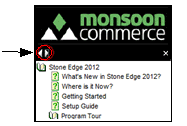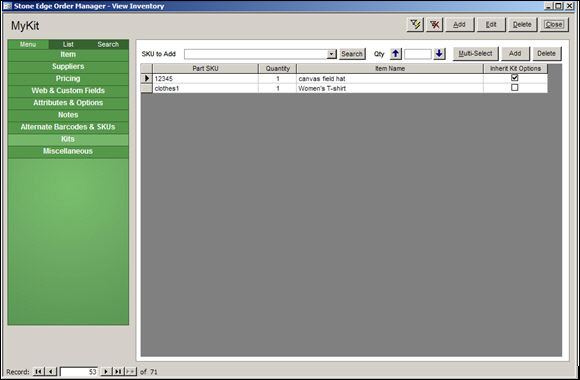
Version 7.1

Version 7.1
![]() Use the Next
Topic and Previous Topic
arrows,
Use the Next
Topic and Previous Topic
arrows, ![]() and
and ![]() ,
in the Navigation Pane of the Knowledge
Base to move sequentially through the topics explaining the Inventory screen.
(The buttons are actually white on the black background of the Navigation
Pane.)
,
in the Navigation Pane of the Knowledge
Base to move sequentially through the topics explaining the Inventory screen.
(The buttons are actually white on the black background of the Navigation
Pane.)

Contents of this Topic: Show
Kits are a collection of inventory items gathered at the time an order is placed to produce a single product, such as a gift basket.
The individual items may be sold separately or together as a kit, but the quantity on hand and cost information is always tracked by the individual components of a kit, not by the Kit SKU (parent).
Think of a Kit as a "virtual" SKU that cannot "broken-down" into its components, unlike an Assembly. It is not necessary, nor possible, to transfer inventory units between the parent SKU and its components.
Once a Kit SKU is defined, it is best to leave it intact rather than changing its components. Create new Kit SKUs as the need arises in order to avoid potential inventory problems when kits are returned or exchanged.
When an order for a Kit SKU is placed, OMS can display just the Kit SKU on the order or it can show the individual components that make up the kit. Hiding the individual line items is the most common choice, as customers can be easily confused by seeing multiple line items when they only purchased one item (the parent Kit SKU). Review system parameters, DefaultShowKitParts, PackingShowKits, PickListShowKits, and ShowPartsonInvoices.
The program always assumes that kits are in stock, the cost of the Kit SKU is zero dollars, and the price of the kit is determined by the price charged at the shopping cart, if the order was imported. Manual orders will use the price that is recorded in OMS 's inventory record of the Kit SKU. The program does not track the QOH or cost by the parent Kit SKU, but by the cost of the individual items that comprise the kit, instead. If inventory tracking is enabled (system parameter CheckInventory=TRUE), OMS will subtract the number of units required to make the kit from the QOH of each individual component. If any components are not in stock, the program will create a backorder with the supplier for the number of pieces required to produce a complete kit. Review system parameter DropShipCheckQOH, which affects the way in which processes drop-shipped items, including kit parts.
If OMS imports a kit SKU from an externally-fulfilled Monsoon order, the program will also consider the kit parts to be externally-fulfilled and their QOH will not be decremented by OMS . Monsoon will be notified of the change in QOH by the inventory synchronization process.
Kits can be defined at:
Main Menu>Accordion>Manage My Inventory>View & Manage My Inventory>Kits
Main Menu>Settings>Inventory Functions>Kits

Inventory: Kits
this button opens the Find a Product screen (Search Inventory) where the user may enter criteria and search for inventory records to add as a kit component
when a record has been selected from the Find a Product screen, its SKU will be populated in the SKU to Add combo box
select this button to open the Select Items to Order (Add Items to Order) screen
this form allows the user to choose more than one component SKU at the same time
when the name of a SKU has been entered into the SKU to Add combo box, either by manually typing one in or selecting one from the list, select Add button to designate the component as part of the kit
to remove a component from the kit, select it in the list at the bottom of the screen and click this button
best business practices dictate that components should only be deleted when initially setting up Kit SKUs
once a Kit SKU has been sold, components should not be changed; create a new Kit SKU instead
the program lists all components of the Kit SKU at the bottom of the screen
the following information about each component is displayed:
if this box is checked, any attributes associated with the Kit SKU itself will be copied into the Options or Freeform Options fields of the resulting line items for each component of the kit when the order is created; no changes are made to the underlying component inventory records themselves
the reason for this behavior is that OMS is unable to discern which attributes apply to which components; therefore, all attributes are copied to each line item and it is the user's responsibility to determine which attribute applies to a given component when filling the order
this applies to manually placed or imported orders but not to Point-of-Sale orders
At the upper corner of the Inventory screen, select Add to create a new inventory record to become the Kit SKU.
While it is possible to select an existing inventory record and define it as a Kit, the recommended practice is to create a new SKU whenever a new combination of products will constitute a kit.
The minimum fields that need to be completed before the new inventory record can be saved are as follows:
Local SKU
Item Name
Unit Cost (which should be zero for kits)
Select Kits in the Accordion and enter or select the product SKU to be a component of the kit in the SKU to Add combo box. The Multi-Select or Search buttons can also be used to enter a product SKU into the SKU to Add combo box.
Enter the number of units of the component included in the kit in the Qty field or use the Up and Down arrows to change the value of the Qty field.
Select Add (next to the Multi-Select button).
Optional: Select the box in the Inherit Kit Options column to have any Option lists (attributes) of the Kit SKU copied into the Options or Freeform Options fields of the component's line item in the order. To learn more about options and attributes review the Knowledge Base topic, Options, Attributes and Sub-SKUs. In the context of this topic, the process of building of sub-SKUs is not relevant nor required.
To add an option list to a Kit SKU, selectn the Attributes/Options tab of the inventory record and follow the instructions in the Knowledge Base topic, Add/Edit Option List screen.
Repeat steps 1 through 6 as many times as necessary until all components of the kit are added to the inventory record of the Kit SKU.
The changes made at this tab are take effect immediately and do not need to be saved.
Created:
Revised: 9/23/14
Published: 04/14/16